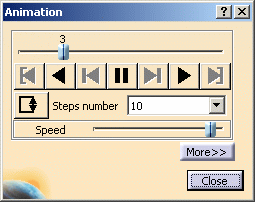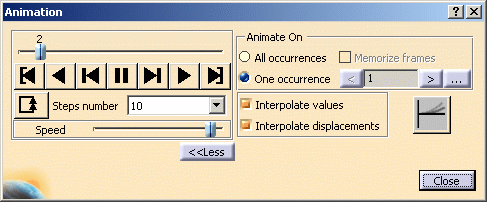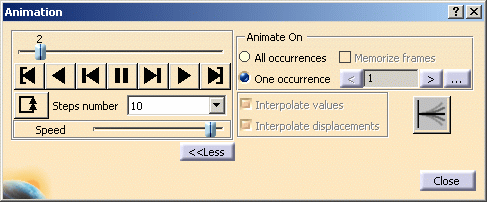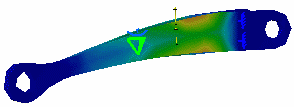This task shows how to animate one image or a multi-selection of images.
Image Animation is a continuous display of a sequence of frames obtained from a given image. Each frame represents the result displayed with a different amplitude. The frames follow each other rapidly giving the feeling of motion.
By animating a deformed geometry or a normal vibration mode, you can get a better insight of the behavior of the system. Sometimes, you gain a more thorough understanding of the system behavior.
Open the sample26.CATAnalysis document from the samples directory.
- Select View > Render Style > Customize View and make sure the Edges and points option is not active and the Materials option is active in the Custom View Modes dialog box.
- Compute the solution.
To do this, click Compute and select the All option.
and select the All option. - Activate the Stress Von Mises image.
To do this, right click the Von Mises Stress (nodal values).2 image from the specification tree and select the Activate/Deactivate contextual menu.
-
Click Animate
 in the Analysis Tools toolbar.
in the Analysis Tools toolbar.The Animation dialog box appears and the image is animated with default animation parameters.

- Slider: lets you manually select the desired step.
- Play:
-
 :
Jump to Start
:
Jump to Start -
 :
Play Backward
:
Play Backward -
 :
Steps Backward
:
Steps Backward -
 :
Pause
:
Pause -
 :
Steps Forward
:
Steps Forward -
 :
Play Forward
:
Play Forward -
 :
Jump to End
:
Jump to End
-
- Change loop mode:
-
 :
plays once in one shot
:
plays once in one shot -
 :
repeats play non stop
:
repeats play non stop -
 :
repeats play and reverse non stop
:
repeats play and reverse non stop
For a smooth animation enter the maximum value (20) as Steps number value and click the Repeat play and reverse non stop
 button.
button. -
- Steps number: makes the animation more or less fluent.
- Speed: lets you manually define the desired speed.
- More: this button expands the Animation dialog box.

The options available in this part of the dialog box depend on the solution type (mono-occurrence or multi-occurrence).
Mono-occurrence solutions:
By default, you can access the following options:
-
Interpolate values: animate the interpolated values of the activated image.
-
Interpolate displacements: animate the interpolated displacements of the activated image.
-
 :
use non symmetrical animation (default value).
:
use non symmetrical animation (default value). -
 :
use symmetrical animation. The color map also becomes
symmetrical.
:
use symmetrical animation. The color map also becomes
symmetrical.
Multi-occurrence solutions:
-
All occurrences: animate all the occurrences of the solution.
-
When activated, this option allows you to choose whether you want to memorize frames:

The frame animation will be speed driven but memory consuming. If you do not select the Memorize frames option, the frame animation will need less memory but will be slower.
Because the Memorize frames option is memory consuming, this option is deactivated by default each time you open this dialog box.
-
-
One occurrence: animate the selected occurrences of the solution.

-
 :
this button lets you select the previous occurrence.
:
this button lets you select the previous occurrence. -
 :
this button lets you select the next occurrence.
:
this button lets you select the next occurrence. -
 :
this button lets you select the desired occurrence using
the Frequencies dialog box.
:
this button lets you select the desired occurrence using
the Frequencies dialog box.
When clicking this button, the Frequencies dialog box appears.
Multi-selection is not available in the Frequencies dialog box. -
Interpolate values: animate the interpolated values of the activated image.
-
Interpolate displacements: animate the interpolated displacements of the activated image.
-
 :
use non symmetrical animation (default value).
:
use non symmetrical animation (default value). -
 :
use symmetrical animation. The color map also becomes
symmetrical.
:
use symmetrical animation. The color map also becomes
symmetrical.
-

In dynamic cases (complex values): when the animation starts, the first step displays the maximum overall displacement of the mode. The phase is animated from 0 to  ,
so the last step displays the opposite maximum.
,
so the last step displays the opposite maximum.
Moreover, the color map is always symmetrical. -
-
Click the Pause
 button.
button.The animation is interrupted.
You access any point of the simulation at random using the slider.






-
If needed, modify the Steps Number and click the More button.
Both the the dialog box and the model appear as shown here:


-
Click the non symmetrical animation
 button.
button.Both the dialog box and the model appear as shown here:


-
Click the Play Forward
 button.
button.Animation is resumed, with the new settings taken into account.
-
Click Close.
- The animation capability is also available for Frequency Solutions.
- You can use the image animation with tiled images using the Images Layout functionality.
![]()